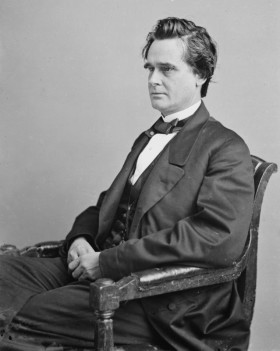
James W. Grimes was a critical force behind the creation of a new political party and Iowa’s current state constitution.
By Jerry Harrington
Since Iowa became a state more than a 150 years ago, 40 people have held the governor’s chair.
All have been male — though there have been several serious female candidates in recent times. Several have been significant players on the national political stage as governors; some became influential U.S. senators and a few were serious presidential candidates.
Most governors tried their best to make sure that state government — from their perspective — served the people of Iowa well. Some distinguished themselves. Others simply served their time in office and memories of these men are lost to history.
With this issue, Iowa History Journal begins a special three-part series on significant governors who hold prominent places in Iowa history. The series cites six of them. They are James W. Grimes (1853-1858), Samuel J. Kirkwood (1860-1864 and 1876-1877), Albert Baird Cummins (1902-1908), Harold Hughes (1963-1969) Robert Ray (1969-1983) and Terry Branstad (1983-1999 and 2011-present).
Some were selected due to the force of their personalities and the positive changes they brought to the state. Grimes in the 1850s and Cummins in the early-1900s are examples. Others were picked because of the trials in their times and the leadership they provided to meet these challenges: Kirkwood during the Civil War period and Harold Hughes in the turbulent 1960s.
There are certainly other governors who made their mark on Iowa history, too. There was William Larrabee in the 1880s, who led efforts to fight railroad abuses; Clyde Herring, who faced the state’s grave challenges during the Great Depression of the 1930s; and William Beardsley in the 1950s, who was influential in dramatically building and improving Iowa’s highways and county roads. These and others may be covered in future issues of Iowa History Journal.
For now, we will concentrate on the six selected governors and their roles in making Iowa the state it is today. As we review these governors’ accomplishments, we will also use these tales to travel down the fascinating and colorful road of Iowa political history.
Gov. James Grimes: Father of the Iowa Republican Party and the Modern Iowa Constitution
As Americans moved westward in the 19th century and built farms, businesses, towns, governments and then cities on the frontier, they often found among them individuals with insatiable energy, unbound ambition and driving restlessness.
On the Iowa frontier, one man that fit that description was James Grimes.
This unique historical figure left several legacies that influence Iowans to this day. He was a critical force behind the creation of a new political party and Iowa’s current state constitution. Grimes was truly one of the indispensable men in Iowa history.
A New Hampshire native who attended Dartmouth College, Grimes staked his future to the Iowa frontier as a 20-year-old in 1836 when he settled in the community that would become Burlington. A farmer, lawyer, banker and businessman, Grimes added “politician” to his list of professions when he was elected to the legislature of the Iowa Territory only two years after he arrived.
Grimes served on-and-off in the legislature over the next several years as more settlers came to the rich, fertile farmland of the Iowa Territory. In 1846, Iowans successfully petitioned Congress for statehood and the Hawkeye State then joined the Union. With this, Grimes saw his chance to climb the political ladder within state politics.
One obstacle, however, stood in his way. Grimes was a committed member of the Whig political party and the Iowa political landscape at the time was dominated by the Democratic Party.
Political parties in the mid-19th century had a different ideological mix than today. The Democrats, followers of Thomas Jefferson and Andrew Jackson, stood for limited government, low taxes, states’ rights and — reflecting Jacksonian ideology — opposition to banks. The Whigs — followers of the “American System” espoused by Kentucky’s Henry Clay — believed in higher national tariffs on imported goods to make domestic goods more competitive; this additional revenue would in turn be invested in internal improvements, such as roads, canals and railways, to help grow American commerce. Whigs supported a strong banking system to help businesses invest and expand.
Democratic ideology prevailed with the first Iowa Constitution of 1846. For one, it outlawed banks. Limited money circulated in Iowa — from other states and territories, along with money substitutes such as receipts and script from local businesses — but this “hard money” policy hindered business growth.
Grimes and his political allies were dedicated to changing the constitution but faced a public that elected Democrats to the state legislature and governorship. Iowa’s first two governors were Democrats — Ansel Briggs of Andrew and Stephen Hempstead of Dubuque.
This was not to last. As Iowa moved into the 1850s, more people migrated into the state from eastern regions such as New England and Ohio. They brought with them the Whig attitude toward government. Also, state leaders were pressured by railroad interests and other businesses to allow banks in Iowa to better manage cash flow and investments.
Most importantly, there was a political upheaval in the 1850s that gave Grimes and others a chance to birth a new political party in Iowa, dramatically changing the Iowa politics for generations.
TO READ MORE ABOUT THIS STORY AND OTHER FASCINATING STORIES ABOUT IOWA HISTORY, subscribe to Iowa History Journal. You can also purchase back issues at the store.
